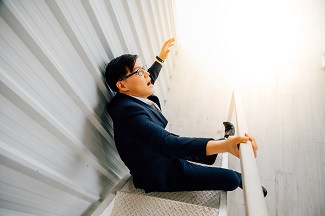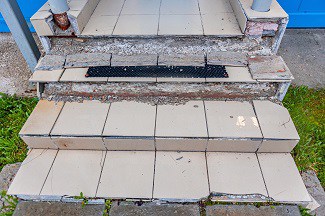How to Prevent Slip & Fall Accidents and Liability: Actionable Tips for Apartment Owners

Many of the falls that take place on stairways have a common cause: missing or defective railings. This is a tragic yet preventable situation.
Fortunately, landlords have the power to change it.
At Deck and Balcony Inspections, Inc., our team has more than 40 years of experience providing comprehensive building inspections. We help California apartment owners ensure the safety of their decks, balconies, walkways, and stairs while remaining in compliance with Senate Bill 721.
In this blog, we’ve compiled our expertise to provide a guide for landlords who want to prevent slip and fall accidents and make the stairways in their apartment buildings as safe as possible.
Let’s dive in.
4 of the Most Common Causes for Slip & Fall Injuries in Apartment Stairways
What causes slip, trip, and fall accidents in apartment stairways?
Here are a few of the most common causes:
1. Faulty handrails
The most common cause of accidents in apartment stairways is missing, faulty, or defective handrails. According to California building codes, stairways must have handrails or stair railings on each side of the stairway unless the stairway is less than four risers tall.
Moreover, the handrails must be a certain height (depending on when the handrail was installed) and length. Handrails that don’t meet these guidelines provide inadequate support for people coming up or down the stairs and can easily cause slip, trip, and fall accidents.
2. Poor lighting
Inadequate lighting is a common cause of slip and fall accidents on stairs – especially outdoor stairs. Inadequate lighting reduces visibility and makes it difficult for visitors or tenants to navigate stairs.
Apartment owners in California are required to maintain a building’s common areas, including lighting and walkways. Apartment owners who fail to provide adequate stairway lighting could be held liable if a tenant slips and falls.
3. Stairway debris
Snow, ice, debris, or clutter on stairways can cause a fall. With this in mind, it’s essential for landlords and property owners always to keep stairways free of debris, even when construction or repairs are taking place on the building.
4. Uneven surfaces
Loose carpet, broken stairs, or uneven floorboards can be dangerous for people going up or down stairs. Uneven surfaces can easily cause a person to stumble, causing a fall down the remainder of the stairway.
Can a Tenant Sue a Landlord After Falling Down the Stairs?

In many cases, the answer is yes.
If a tenant falls down the stairs, the type of claim they file will likely be a premises liability claim. In these situations, the burden of proof falls on the plaintiff or the person making the claim.
That means that the tenant must prove the following:
- The landlord knew the staircase’s condition was dangerous, and
- The landlord did not take the steps required to resolve the hazardous condition, or
- Post sufficient warnings to keep tenants off the stairway or make them aware of its dangerous condition.
If the tenant can prove those things, the landlord may be held liable for any damages or expenses incurred by the tenant.
When a tenant does file a premises liability claim, the tenant’s attorney will usually send someone out to investigate the property. If, during this inspection, the property inspector finds that the building’s stairways are not up to code or a handrail is even a fraction of an inch too high or low, it may be considered negligence on the part of the landlord. In this case, the landlord would be legally liable for any damages.
Because of this, landlords must invest in routine property inspections. In addition to ensuring compliance with SB-721, these inspections also ensure stairs are safe, up to code, and unlikely to cause injury.
How Can Apartment Owners, Managers, and Landlords Make Their Stairways Safer?
Property owners and managers have a legal obligation to maintain the common areas of their apartment buildings, including the stairs. With that in mind, here are a few tips for property managers who want to make their stairways safer:
1. Keep the stairway and the paths leading to and from it clean and clear
Tripping hazards of all kinds should be removed from stairs and surrounding areas. Cords, decorations, area rugs, and clutter, for example, are all tripping hazards.
The stairs should also be clear of ice and snow during the winter and cleared of all storm-related debris, like leaves or downed branches, as quickly as possible after a severe weather event.
2. Make sure handrails are present and up to code
Every stairway on your property should have handrails. The handrails should be sturdy, in good repair, and up to current building codes. Handrails that are broken or damaged should be repaired immediately, or the stairways should be roped off to prevent tenants from using them until the repair is complete.
3. Repair broken steps or uneven flooring promptly
Broken stairs or risers or warped, uneven flooring should be repaired immediately. These things represent imminent tripping hazards and should be resolved to keep tenants safe.
4. Make sure stairs aren’t too steep

Stairways in older buildings tend to be steep and narrow. Unfortunately, these steep stairways increase the risk of slip and fall accidents.
According to current California building codes, the rise of each step should be no less than 4” and no more than 7”, while the minimum tread should be 11” and there should be a maximum of ⅜” variance from one step to the next.
Guard rails, meanwhile, should be a minimum of 42” high, while handrails should be a minimum of 34” and a maximum of 36” in height. Handrails should also have a minimum of a 12” extension past both the tops and bottoms of stairs.
Finally, a minimum of 48” of landing is required at both the tops and bottoms of the stairs. The landing must be as wide as the stairs and cannot have more than 2% in cross or forward slope. Stairways that do not meet these code requirements may need to be rebuilt for safety.
5. Invest in routine building inspections
The best way to keep your stairways safe is to hire a professional building inspector for routine inspections of your stairways and other exterior elevated elements (EEEs).
These inspections allow you to identify possible issues before they become dangerous and ensure you’re always keeping your stairways safe for your tenants and visitors.
Want to Make Your Stairways Safer? Schedule Your Professional Inspection Today
As a landlord, keeping tenants safe is your top priority. At Deck and Balcony Inspections, Inc., it’s our priority, too.
If you’re not sure your stairway would survive legal scrutiny after a slip and fall accident, now is the time to act.
Our team of professional California building inspectors will help ensure your stairways are safe and up to code and that you have a chance to make any needed repairs before they become critical.
Ready to learn more about our team or request your FREE quote? Contact us today!
DISCLAIMER: The resources provided by Deck & Balcony Inspections, Inc., are for educational purposes only and do not constitute legal advice. Consult your counsel if you have legal questions about your specific practices and compliance with applicable laws.















 Accessibility
Accessibility